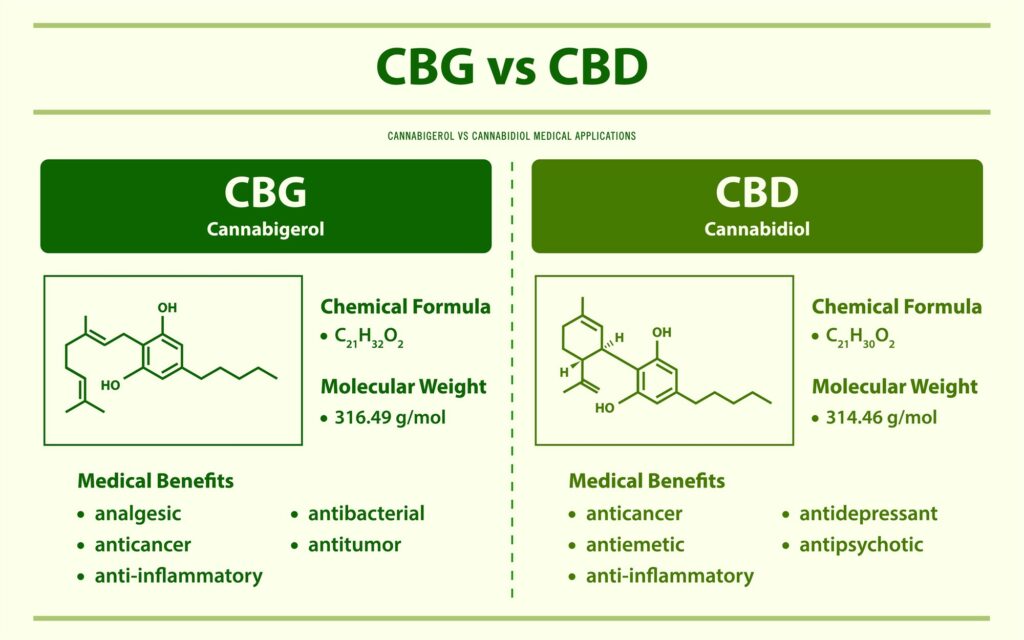The cannabinoid industry has rapidly expanded, with one cannabinoid, in particular, attracting considerable attention—Cannabigerol, or as it’s more commonly known, CBG. This article will delve into what CBG is, its potential benefits, and potential CBG side effects.
What is CBG?
CBG, or Cannabigerol, is one of the hundreds of cannabinoids found in the cannabis plant, similar to its more well-known counterparts, THC and CBD. However, CBG is often referred to as the ‘mother of all cannabinoids’ as it serves as the precursor from which all other cannabinoids are synthesized.
CBG and the Endocannabinoid System
The human body has an intricate system known as the endocannabinoid system (ECS). This system regulates numerous physiological functions such as sleep, pain, mood, and immune response. Cannabinoids like CBG interact with the ECS, specifically with the CB1 and CB2 receptors, influencing these functions.
Potential Benefits of CBG
Early research into CBG has unearthed potential therapeutic benefits. Although more comprehensive studies are needed, preliminary findings suggest that CBG may help with various health conditions.
- Neuroprotective Effects: Animal studies indicate that CBG might have neuroprotective properties, possibly benefiting conditions like Parkinson’s disease and Huntington’s disease.
- Eye Health: CBG has been observed to reduce intraocular pressure, which could be beneficial in conditions like glaucoma.
- Anti-Inflammatory: CBG exhibits anti-inflammatory properties, potentially aiding in conditions like inflammatory bowel disease.
- Antibacterial: Interestingly, CBG has shown promise as a potent antibacterial agent.
Remember, while these potential benefits are promising, they are based on early research. More comprehensive human trials are needed to verify these effects.
Chronic Pain and the Role of CBG
Pain is something many individuals deal with daily. One of the areas where CBG shows promise is in the management of chronic pain. Some early studies found that CBG might help reduce inflammation and block pain signals, making it a potential option for those dealing with persistent pain.
Introduction to CBGA another CBG Concentration
To truly understand CBG, one must also know about cannabigerolic acid or CBGA. This is the acidic form of CBG, serving as the precursor to three major cannabinoid lines: THCA, CBDA, and CBCA. The cannabis plant primarily produces CBGA, which then gets converted into other cannabinoids, thus earning it the title ‘mother of cannabinoids’.
Side Effects of CBG
CBG, like its cousin CBD, is thought to have several therapeutic effects. While the effects of CBG are still being studied, it’s becoming clear that this type of cannabinoid may have a wide range of potential benefits.
As with any compound, understanding potential CBG side effects is crucial. Generally, CBG is considered safe and non-toxic. However, possible side effects might include dry mouth, lightheadedness, and changes in appetite or mood.
It is important to note that the interaction between CBG and other medications is not thoroughly studied. Therefore, if you’re considering CBG and are on any medication, it’s essential to consult with a healthcare provider first.
The Difference Between CBG and CBD Products

What’s the difference between CBD and CBG? While they are both cannabinoids derived from the cannabis plant, they have different origins. CBD comes from cannabidiolic acid (CBDA), while CBG comes from cannabigerolic acid (CBGA). Despite their different origins, both interact with the CB1 and CB2 receptors in the body and may offer health benefits.
CBG Products and CBD Oils
If you’ve browsed the wellness aisle recently, you might have noticed a surge of cannabis preparations, including CBG products and CBD oils. CBG and CBD-based tinctures are becoming increasingly popular as consumers seek out natural alternatives for health and wellness.
Understanding the effects of CBG and CBD and the Risks OF CBG
The potential benefits and risks associated with CBG are still being uncovered. While some studies have found that CBG may offer therapeutic effects, it’s equally important to understand the possible side effects. Some reported side effects of CBG include changes in appetite, mood, and fatigue. However, it’s also worth noting that these side effects are typically mild and temporary.
A Unique Cannabinoid Derived from the Cannabis Plant
ICBG is a unique cannabinoid derived from the cannabis plant with the potential to offer several health benefits. From its potential role in managing chronic pain to its antibacterial properties, the therapeutic effects of CBG are beginning to be recognized. However, as with any new product, it’s important to be aware of the potential risks. Always consult with a healthcare provider before adding CBG or any new supplement to your regimen. The future of CBG research is bright, and we look forward to seeing what discoveries lie ahead.
How iT Works and is Different from Other Cannabinoids?
CBG stands out among other cannabinoids for a few reasons. Firstly, it’s non-psychoactive, meaning it doesn’t produce the ‘high’ associated with THC. Secondly, it’s less concentrated in the cannabis plant. Most cannabis strains contain less than 1% of CBG, making it less common than THC or CBD.
The Future
CBG has garnered attention from scientists, medical professionals, and consumers alike. As researchers continue to unearth the potential of this ‘mother of all cannabinoids,’ the future of CBG appears promising.
It’s an exciting time in cannabinoid research. The increased understanding and acceptance of these compounds are unlocking new potential treatments for a range of conditions. As we uncover more about the benefits and CBG side effects, it becomes even clearer that the realm of cannabinoids holds a wealth of yet-to-be-discovered potential.
CBG vs CBD and THC
One key question many have is how CBG compares to CBD and THC. As mentioned, CBG is the precursor to all other cannabinoids, including these two. They interact with the body’s endocannabinoid system without producing a high.
While CBD has received significant attention due to its potential therapeutic benefits, CBG is still relatively new in the public consciousness. It’s worth noting that they may have different therapeutic benefits. For instance, while CBD has been studied for its potential effects on epilepsy, anxiety, and sleep disorders, CBG has potential benefits related to neuroprotection, eye health, and bacterial infections.
Final Thoughts on Cannabigerol
As the scientific community continues to explore the possibilities offered by the cannabis plant, Cannabigerol (CBG) holds a unique and promising place. Its potential therapeutic benefits combined with its non-psychoactive nature could make it a viable option for those seeking alternative treatments.
It’s important to remember, though, that research is still in its early stages. Much like any other emerging treatment, it’s essential to approach CBG with an understanding of its potential benefits, CBG concentration, and possible CBG side effects.
In a world where interest in cannabinoids is increasing, CBG stands as a testament to the potential benefits and therapeutic versatility of these compounds. As we deepen our understanding of CBG and the endocannabinoid system, the horizon seems bright for this lesser-known cannabinoid. Here’s to further research and the continued exploration of the immense potential of Cannabigerol.
Given its unique properties and potential benefits, there’s no doubt that CBG is a cannabinoid worth watching. As we venture further into the world of cannabinoids, it’s clear that the journey has just begun—and what an exciting journey it promises to be.
FAQS
What is Cannabigerol (CBG)?
Cannabigerol, often referred to as CBG, is a non-psychoactive cannabinoid found in the Cannabis Sativa plant, just like CBD and THC. Unlike THC, CBG does not produce a high. CBG is now referred to as the ‘mother’ or stem cell’ of cannabinoids and serves as the precursor for other cannabinoids such as THC and CBD. It’s being extensively researched for its potential therapeutic benefits, including pain relief, anti-inflammatory, and neuroprotective properties.
What are the potential health benefits of Cannabigerol (CBG)?
Current research suggests that Cannabigerol (CBG) may offer a range of potential health benefits. It also shows promise as a neuroprotective agent, potentially helping conditions such as Parkinson’s and Huntington’s disease. Moreover, some studies indicate that CBG might have antibacterial properties, particularly against MRSA. Remember, while these findings are promising, more research is required to fully understand the extent and mechanisms of CBG’s potential benefits.
Cannabigerol (CBG) different from Cannabidiol (CBD) and Tetrahydrocannabinol (THC)?
While Cannabigerol (CBG), Cannabidiol (CBD), and Tetrahydrocannabinol (THC) are all cannabinoids found in the Cannabis Sativa plant, they have different properties and effects. While all three compounds are being researched for their potential health benefits, they interact with the body’s endocannabinoid system differently, which leads to varying effects and potential uses in health and medicine.
To View the Little Health Company store click here
Disclaimer: Please consult with a healthcare provider before using CBD products, especially if you are pregnant, nursing, have a medical condition or are taking any medication.

